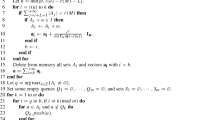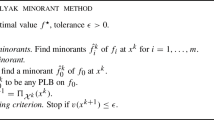Abstract
Semidefinite programming (SDP) relaxations are proving to be a powerful tool for finding tight bounds for hard discrete optimization problems. This is especially true for one of the easier NP-hard problems, the Max-Cut problem (MC). The well-known SDP relaxation for Max-Cut, here denoted SDP1, can be derived by a first lifting into matrix space and has been shown to be excellent both in theory and in practice.
Recently the present authors have derived a new relaxation using a second lifting. This new relaxation, denoted SDP2, is strictly tighter than the relaxation obtained by adding all the triangle inequalities to the well-known relaxation. In this paper we present new results that further describe the remarkable tightness of this new relaxation. Let \(F_n \) denote the feasible set of SDP2 for the complete graph with n nodes, let F n denote the appropriately defined projection of \(F_n \) into \(S^n \), the space of real symmetric n × n matrices, and let C n denote the cut polytope in \(S^n \). Further let \(Y \in F_n \) be the matrix variable of the SDP2 relaxation and X ∈ F n be its projection. Then for the complete graph on 3 nodes, F 3 = C 3 holds. We prove that the rank of the matrix variable \(Y \in F_3 \) of SDP2 completely characterizes the dimension of the face of the cut polytope in which the corresponding matrix X lies. This shows explicitly the connection between the rank of the variable Y of the second lifting and the possible locations of the projected matrix X within C 3. The results we prove for n = 3 cast further light on how SDP2 captures all the structure of C 3, and furthermore they are stepping stones for studying the general case n ≥ 4. For this case, we show that the characterization of the vertices of the cut polytope via rank Y = 1 extends to all n ≥ 4. More interestingly, we show that the characterization of the one-dimensional faces via rank Y = 2 also holds for n ≥ 4. Furthermore, we prove that if rank Y = 2 for n ≥ 3, then a simple algorithm exhibits the two rank-one matrices (corresponding to cuts) which are the vertices of the one-dimensional face of the cut polytope where X lies.
Similar content being viewed by others
References
M.F. Anjos, “New convex relaxations for the Maximum Cut and VLSI layout problems,” Ph.D. Thesis, University of Waterloo, 2001. Available online at http://etd.uwaterloo.ca/etd/manjos2001.pdf.
M.F. Anjos and H. Wolkowicz, “Strengthened semidefinite relaxations via a second lifting for the Max-Cut problem,” Discrete Appl. Math., vol. 199, no. 1-2, pp. 79–106, 2002.
F. Barahona, “The max-cut problem on graphs not contractible to K5,” Oper. Res. Lett., vol. 2, no. 3, pp. 107–111, 1983.
F. Barahona, “On cuts and matchings in planar graphs,” Math. Programming, vol. 60, no. 1 (Ser. A), pp. 53–68, 1993.
F. Barahona, M. Grötschel, M. J¨unger, and G. Reinelt, “An application of combinatorial optimization to statistical physics and circuit layout design,” Oper. Res., vol. 36, pp. 493–513, 1988.
F. Barahona and A.R. Mahjoub, “On the cut polytope,” Math. Programming, vol. 36, no. 2, pp. 157–173, 1986.
S.J. Benson, Y. Ye, and X. Zhang, “Solving large-scale sparse semidefinite programs for combinatorial optimization,” SIAM J. Optim., vol. 10, no. 2, pp. 443–461 (electronic), 2000.
S. Burer and R.D.C. Monteiro, “A projected gradient algorithm for solving the maxcut SDP relaxation,” Optim. Meth. Softw., vol. 15, pp. 175–200, 2001.
M.M. Deza and M. Laurent, Geometry of Cuts and Metrics, Springer-Verlag: Berlin, 1997.
U. Feige and G. Schechtman, “On the optimality of the random hyper plane rounding technique for MAX CUT,” Technical report, Weizmann Institute, Rehovot, Israel, 2000.
M.R. Garey and D.S. Johnson, Computers and Intractability: A Guide to the Theory of NP-Completeness, Freeman: San Francisco, 1979.
M.X. Goemans, “Semi definite programming in combinatorial optimization,” Math. Programming, vol. 79, pp. 143–162, 1997.
M.X. Goemans, “Semi definite programming and combinatorial optimization,” Documenta Mathematica, Extra Volume ICM 1998, pp. 657–666, 1998.
M.X. Goemans and F. Rendl, “Combinatorial optimization,” in Handbook of Semidefinite Programming: Theory, Algorithms, and Applications, H. Wolkowicz, R. Saigal, and L. Vandenberghe (Eds.), Kluwer Academic Publishers: Boston, MA, 2000.
M.X. Goemans and D.P. Williamson, “.878-approximation algorithms for MAX CUT and MAX 2SAT,” in ACM Symposium on Theory of Computing (STOC), 1994.
M.X. Goemans and D.P. Williamson, “Improved approximation algorithms for maximum cut and satisfiability problems using semi definite programming,” J. Assoc. Comput. Mach., vol. 42, no. 6, pp. 1115–1145, 1995.
J. Hastad, “Some optimal in approximability results,” in Proc. of the 29th ACM Symp. on Theory Comput., 1997.
C. Helmberg, “An interior-point method for semi definite programming and max-cut bounds,” PhD Thesis, Graz University of Technology, Austria, 1994.
C. Helmberg and F. Oustry, “Bundle methods to minimize the maximum eigenvalue function,” in Handbook of Semidefinite Programming: Theory, Algorithms, and Applications, H. Wolkowicz, R. Saigal, and L. Vandenberghe (Eds.), Kluwer Academic Publishers: Boston, MA, 2000.
C. Helmberg, S. Poljak, F. Rendl, and H. Wolkowicz, “Combining semidefinite and polyhedral relaxations for integer programs,” in Integer Programming and Combinatorial Optimization (Copenhagen, 1995), Springer: Berlin, 1995, pp. 124–134.
C. Helmberg and F. Rendl, “A spectral bundle method for semi definite programming,” SIAM J. Optim., vol. 10, no. 3, pp. 673–696, 2000.
C. Helmberg, F. Rendl, R.J. Vanderbei, and H. Wolkowicz, “An interior-point method for semi definite programming,” SIAM J. Optim., vol. 6, no. 2, pp. 342–361, 1996.
R.A. Horn and C.R. Johnson, Matrix Analysis, Cambridge University Press: Cambridge, 1990.
R.M. Karp, “Reducibility among combinatorial problems,” in Complexity of Computer Computation, R.E. Miller and J.W. Thatcher (Eds.), Plenum Press: New York, 1972, pp. 85–103.
J.B. Lasserre, “Optimality conditions and LMI relaxations for 0-1 programs,” LAAS research report 00099, LAAS-CNRS, Toulouse, France, 2000.
M. Laurent, “Tighter linear and semi definite relaxations for max-cut based on the Lovász-Schrijver lift-and-project procedure,” SIAM J. Optim., vol. 12, pp. 345–375, 2001 (electronic publication).
M. Laurent and S. Poljak, “On a positive semi definite relaxation of the cut polytope,” Linear Algebra Appl., vol. 223/224, pp. 439–461, 1995.
M. Laurent and S. Poljak, “On the facial structure of the correlation matrices,” SIAM J. Matrix Anal. Appl., vol. 17, no. 3, pp. 530–547, 1996.
T. Lengauer, Combinatorial Algorithms for Integrated Circuit Layout, JohnWiley & Sons Ltd.: Chichester, 1990.
B. Mohar and S. Poljak, “Eigenvalues in combinatorial optimization,” in Combinatorial Graph-Theoretical Problems in Linear Algebra, IMA, vol. 50, Springer-Verlag: Berlin, 1993.
Y.E. Nesterov, “Quality of semidefinite relaxation for non convex quadratic optimization,” Technical report, CORE, Universite Catholique de Louvain, Belgium, 1997.
Y.E. Nesterov, H. Wolkowicz, and Y. Ye, “Semi definite programming relaxations of nonconvex quadratic optimization,” in Handbook of Semi definite Programming: Theory, Algorithms, and Applications, H. Wolkowicz, R. Saigal, and L. Vandenberghe (Eds.), Kluwer Academic Publishers: Boston, MA, 2000, p. 34.
P. Parrilo, “Structured semi definite programs and semi algebraic geometry methods in robustness and optimization,” Ph.D. Thesis, Caltech, Pasadena, California, 2000.
F. Rendl, “Semi definite programming and combinatorial optimization,” Appl. Numer. Math., vol. 29, pp. 255–281, 1999.
H. Wolkowicz, R. Saigal, and L. Vandenberghe (Eds.), Handbook of Semi definite Programming: Theory, Algorithms, and Applications, Kluwer Academic Publishers: Boston, MA, 2000, pp. xxvi+654.
Y. Ye, “Approximating quadratic programming with bound and quadratic constraints,” Math. Programming, vol. 84, pp. 219–226, 1999.
Author information
Authors and Affiliations
Rights and permissions
About this article
Cite this article
Anjos, M.F., Wolkowicz, H. Geometry of Semidefinite Max-Cut Relaxations via Matrix Ranks. Journal of Combinatorial Optimization 6, 237–270 (2002). https://doi.org/10.1023/A:1014895808844
Issue Date:
DOI: https://doi.org/10.1023/A:1014895808844




